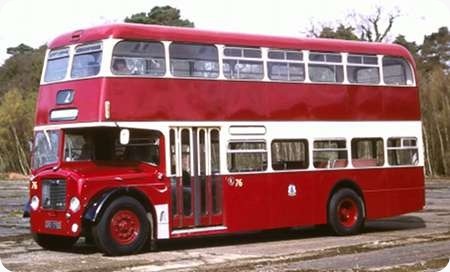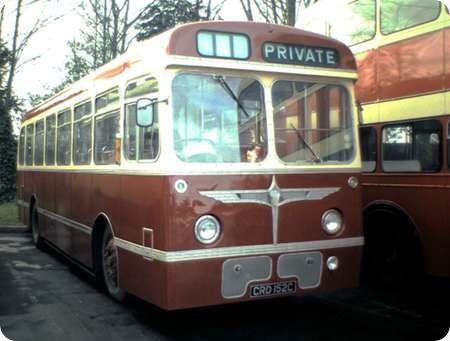Reading Corporation – Dennis Loline – GRD 576D – 76
Reading Corporation
1966
Dennis Loline III
East Lancs H38/30F
Here is a Reading Corporation Dennis Loline III with an East Lancs H38/30F bodywork, and is seen arriving at Wisley Airfield for the "Cobham" Running Day on 4 April, 2004. The Loline, as most know already, was the Bristol Lodekka built under licence by Dennis of Guildford, and the Loline III with forward door makes an interesting comparison with the FLF version of the Lodekka.
Photograph and Copy contributed by Pete Davies
17/05/13 – 07:21
A beautiful picture of a beautiful vehicle. It has been said that arguably the best looking AEC Renowns are the East Lancs versions (particularly Leigh and West Bridgeford). This is the Dennis Loline equivalent – and equally good looking. The Reading livery helps to set it off.
David Oldfield
17/05/13 – 09:05
The forward entrance East Lancs bodied Loline III was the nearest the Loline got in looks to the FLF – if the upper deck emergency exit had been changed to a single bay the similarity would have been very close, with the visual advantage of a more balanced side window bay arrangement.
Phil Blinkhorn
17/05/13 – 09:06
Agreed on all points David – I just hope that Mr. Stenning doesn’t see the picture, or the poor soul will think that his life’s work has been in vain.
Chris Youhill
17/05/13 – 10:39
Well hasn’t it all been in vain, Chris. [If you take notice of the number of remarks concerning his modern liveries!]
David Oldfield
17/05/13 – 12:40
Thank you, gents, for your kind remarks!
Pete Davies
19/05/13 – 07:20
This vehicle was one of the last batch of eight Loline IIIs bought by Reading in December 1966 and January 1967. The first eight Lolines for Reading came in September 1962, and had rear axles and four speed gearboxes by Dennis. These were followed by ten more in July-September 1964, but these had Bristol rear axles and five speed gearboxes with the overdrive ratio blanked off, which limited top speed to a shade above 30 mph. The last eight, of which 76 above is a representative, were similarly engineered. Quite why Reading specified the Bristol transmission components, especially the five speed boxes which the Corporation then blanked off, is puzzling. At this time Aldershot and District were accepting the delivery of Lolines equipped with wholly Dennis transmissions, so the Reading choice of Bristol componentry must have been made on the grounds of cost. The point has been made before on this site that the Loline, and particularly the Mark III, was rather more than "a licence built Lodekka". Dennis made several changes to the design, and all Lolines from the Mark I had a full air braking system, unlike the Bristol which stuck with air/hydraulic to the end. As one who has driven both Lolines and Lodekkas, I think that the Dennis was the nicer of the two types. Both Ian Thompson and Alan Murray-Rust who have first hand knowledge of these Reading Lolines in service have made insightful comments under the entry for North Western – Dennis Loline III – RDB 892.
Roger Cox
19/05/13 – 07:23
The Dennis Loline always lived in the shadow of the Bristol FLF in terms of sales numbers largely due to the radically different purchasing policies of the vehicles’ respective client base. Whereas the BTC companies, which were the only purchasers of the Lodekka allowed by legislation, standardised on a low-height design whether it was actually needed or not, the BET Group companies and municipalities only generally bought such vehicles where low bridges dictated a definite requirement. In those days before disabled access legislation no-one ever seemed to consider a major advantage of the Loline and indeed the other low-height designs of providing a low-height single step entrance. Had such legislation been in place in those days then the Loline could have had a very different history.
I agree that this is a superb picture of a fine vehicle in a classic municipal livery. It still looks good nearly 50 years on but that is the mark of pure quality.
Philip Halstead
20/05/13 – 09:05
Just realised—that’s me at the tiller and wife and daughter up aloft! From about 1955 onwards, as a new model popped up every few years and then disappeared from the market, you heard people predicting the final demise of Dennis as a busbuilder, yet here they are with highly successful products in 2013. Admittedly much changed, but the name lives on!
I’ve also got a very soft spot for East Lancs bodywork, so that Loline has it all.
Pity that one of the ’62 batch didn’t survive, but those then very saleable Gardner engines ensured that withdrawn 6LX-powered buses didn’t just moulder away as chicken sheds—to be discovered decades later by delighted enthusiasts—but got cut up for scrap.
Fine picture, Pete. Thanks.
Ian Thompson
20/05/13 – 16:54
Ian,
If you’d like a copy for posterity, the family archives, or whatever, I’m quite happy for Peter to forward it to you.
Pete Davies
22/05/13 – 09:41
Thanks for the very kind offer, Pete, which I’d be delighted to take up.
Ian Thompson
Quick links to the - Comments Page - Contact Page - Home Page


